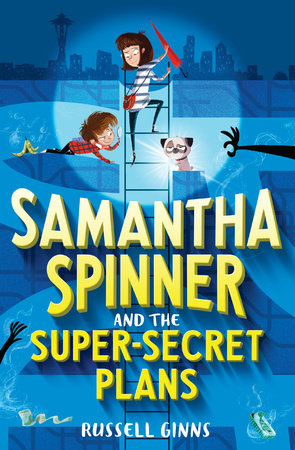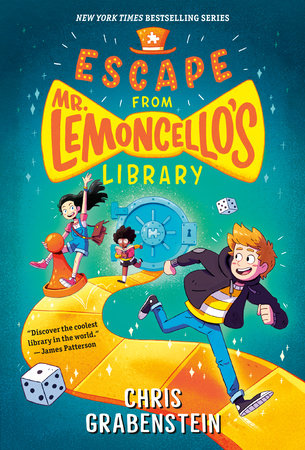Chris Grabenstein and Russell Ginns Make the Case for Puzzle-Filled
Kids’ Books
by the Brightly Editors
At Brightly, we’re huge fans of adventure books that pull middle grade readers into the action and keep them turning the pages and laughing right until the very end. That’s why we were thrilled to have Chris Grabenstein, the bestselling creator of the fan-favorite Mr. Lemoncello’s Library and Welcome to Wonderland series, interview Russell Ginns, a prolific game designer and author of the brand-new Samantha Spinner adventure series. The two game-loving authors chatted about why puzzle mysteries captivate kids, which twisty-turny books for middle grade readers they’ve loved most, and what makes Samantha Spinner and the Super-Secret Plans so exciting. (They also talked about cereal — yes, cereal.) Read on for their fun and fascinating conversation!
CHRIS GRABENSTEIN: Tell us about your career as a game designer. And have you ever worked for Mr. Luigi Lemoncello’s Imagination Factory?
RUSSELL GINNS: I started out in kids’ magazines (made of paper!). I wrote reviews of games and software. The more I looked at different games, the more I started to figure out how they were put together. Soon I got involved in testing and designing them. I also worked on the Nintendo Adventure Books. This was a choose-your-adventure series starring the Mario Brothers. It got tricky because they were branching stories and I hade to come up with 32 different ways to smash/destroy/kill Mario and Luigi in every book. I used up all the obvious methods quickly. Eventually, I had them turned into sandwiches and eaten, and blown up like balloons and popped. It just got weirder and weirder.
I haven’t worked with the Imagination Factory … yet. It sounds like it’s my kind of place. I believe in the power of smart fun. Mr. Lemoncello is a superstar!
How do you design a book that is really a big game?
First and foremost, the characters have to be compelling. If readers care about them, then they will follow along through tunnels and secret doors and 1,000-mph conveyor belts.
But it all begins with an outline. I make a diagram that shows all the places the characters go, all the most important clues they find, and the stuff they collect. It’s just like designing a game.
What puzzle mysteries did you enjoy reading when you were a kid?
I read all the Encyclopedia Brown books, and I loved From the Mixed-Up Files of Mrs. Basil E. Frankweiler. I gave a little nod to that book in Samantha Spinner and the Super-Secret Plans. Sam and her brother keep asking, “How do all these mixed-up things fit together?”
I am also a huge fan of Holes by Louis Sachar. (I was already a grown-up when I read it.) It’s not really a puzzle book, but I am astounded by how all the parts of the story intertwine and go back and forth in time. It’s an amazing and complicated achievement. I don’t know how he did it.
Any deep thoughts about why books with games and puzzles built into them are so much fun?
Oh yes. Puzzles let readers get more involved and feel like they’re part of the adventure. That’s why people love game shows on TV. Mystery stories — and any book with a good plot, really — work because readers try to guess what’s happening along with the characters. Books with puzzles and hidden clues add extra layers of involvement and fun!
I thought I had written a lot of books! You’ve written over 100. So now I have to ask the question kids ask me all the time: Which one is your favorite?
I wrote a board book called Is There a Chance You’ve Seen My Pants? It’s fun introducing yourself to people with “Hi. I’m the author of Is There a Chance You’ve Seen My Pants?” However, Samantha Spinner will be the first series I’ve written with characters who have real depth to them, and I get to keep writing about them and learning more and more about who they are. I love Samantha and Nipper so much. That’s why I’m putting tons of energy into visiting schools and libraries and sharing the stories and puzzles about them.
Can you give us any hints about the puzzles hidden in the book?
Well … two of the puzzles will send you to secret websites where there are more puzzles to solve. All these clues are a way to enjoy the story long after the first read is done. Oh, also … watch out for chinchillas. They seem nice at first, but you can have too much of a good thing!
Are your geographical tips really true? Like the special rivet (it’s actually a button) on the Eiffel Tower?
The first section of each geography tip is true. There are amazing places out there and this book series is really about being fearless and discovering wonders everywhere. The second half of each section — the buttons and tubes and levers — that’s the part I made up so Samantha and Nipper (and readers) could travel the world.
Can you share the poem you wrote that appeared on the back of a cereal box?
When I was just starting out, I got to write a little poem for boxes of Post Alpha-Bits cereal:
There’s a world full of wonderful words, take a look.
You can spot them on signs or a box or a book.
An O is an O so it never should trouble you —
But wait! Is that letter an M or a W?
So spoon out a story, a riddle, a scene,
With an A and a Z and the letters between.
If I’m really lucky, and if a whole lot of kids like Samantha Spinner, then in 20 or 30 years, as many people will have read those books as the number of cereal boxes that exist with that poem.
Know a middle grade reader who loves games, puzzles, and all-around fun? Check out the first installment of the Samantha Spinner series and Grabenstein’s Mr. Lemoncello’s Library series!
-
Escape from Mr. Lemoncello’s Library
Also available from:


